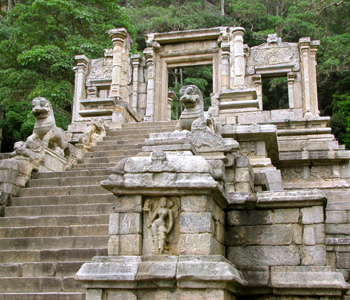
Yapahuwa was one of the ephemeral capitals of medieval Sri Lanka. The citadel of Yapahuwa lying midway between Kurunagala and Anuradhapura was built around a huge granite rock rising abruptly almost a hundred meters above the surrounding lowlands.
In 1272, King Bhuvenakabahu transferred the capital from Polonnaruwa to Yapahuwa in the face of Dravidian invasions from South India, bringing the Sacred Tooth Relic with him. Following the death of King Bhuvenakabahu in 1284, the Pandyans of South India invaded Sri Lanka once again, and succeeded in capturing Sacred Tooth Relic. Following its capture, Yapahuwa was largely abandoned and inhabited by Buddhist monks and religious ascetics.
Yapahuwa Rock Fortress
- A massive rock citadel built as a defensive stronghold.
- Features steep stairways, fortress walls, and palace ruins.
- A historical masterpiece showcasing the ingenuity of Sri Lankan architects.
The Ornate Staircase
- The most iconic feature of Yapahuwa, leading to the ancient temple.
- Decorated with intricate carvings of lions, dancers, and floral motifs.
- Often compared to the famous staircases in Sigiriya and Anuradhapura.
Ancient Temple Ruins (Former Temple of the Tooth)
- Once housed the Sacred Tooth Relic of Buddha, before it was moved to Kandy.
- Features remnants of stone pillars, Buddhist carvings, and inscriptions.
- An important site for Sri Lankan Buddhist history.
Yapahuwa Cave Temples
- Small, hidden caves with ancient murals and Buddhist statues.
- Used by monks for meditation centuries ago.
Summit Viewpoint
- A moderate hike to the top of the rock.
- Offers stunning panoramic views of the lush landscapes below.
- Ideal for photography and peaceful reflection.

